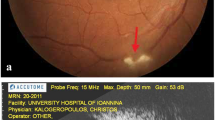Abstract
Background
Ocular toxoplasmosis is a common cause of ocular inflammation worldwide. The aim of this study is to characterize the clinical outcomes and lesion evolution of patients with ocular toxoplasmosis and to compare the primary and reactivation subgroups.
Methods
A retrospective population-based cohort study at one uveitis-specialized tertiary referral center. Patients presenting with active ocular toxoplasmosis between the years 2007–2016 were included. Primary ocular toxoplasmosis and reactivations were compared.
Results
Included were 22 patients, 64% female with a mean age of 29 ± 18 years, 59% (n = 13) were primary, 9% (n = 2) congenital and 32% (n = 7) reactivations. Visual acuity improved from 0.38 ± 0.44 to 0.20 ± 0.27 LogMAR (P = 0.026) after a mean of 37 ± 33 months. Initial lesion size was 2.38 ± 1.1 optic disc areas, reducing to 1.56 ± 1.24 following 2 months (34% reduction, P = 0.028) and to 1.17 ± 0.87 disc areas following one year (51% reduction, P = 0.012). Patients with macula-threatening lesions had worse visual acuity (0.50 ± 0.46 vs. 0.05 ± 0.07 LogMAR, P = 0.047). Primary and reactivation subgroups had similar presentations, visual outcomes and recurrence rates (all P > 0.05).
Conclusions
In this population, primary ocular toxoplasmosis was the most common presentation. Lesion size reduced during the initial months with limited change thereafter and a third of cases recurred. Macula-threatening lesions were associated with worse visual acuity, and no significant differences were seen between the primary and reactivation subgroups.




Similar content being viewed by others
References
Weiss LM, Dubey JP (2009) Toxoplasmosis: a history of clinical observations. Int J Parasitol 39(8):895–901
Oréfice F, Vasconcelos-Santos DV, Costa RA, Oréfice JL (2016) Toxoplasmosis. In: Zierhut M, Pavesio C, Ohno S, Orefice F, Rao N (eds) Intraocular Inflammation. Springer, Berlin. https://doi.org/10.1007/978-3-540-75387-2_138
Holland GN (2003) Ocular toxoplasmosis: a global reassessment. Part I: epidemiology and course of disease. Am J Ophthalmol 136(6):973–988
McCannel CA, Holland GN, Helm CJ, Cornell PJ, Winston JV, Rimmer TG (1996) Causes of uveitis in the general practice of ophthalmology: UCLA Community-Based Uveitis Study Group. Am J Ophthalmol 121(1):35–46
Kovacevic-Pavicevic D, Radosavljevic A, Ilic A, Kovacevic I, Djurkovic-Djakovic O (2012) Clinical pattern of ocular toxoplasmosis treated in a referral centre in Serbia. Eye (London, England) 26(5):723–728
de-la-Torre A, Lopez-Castillo CA, Gomez-Marin JE (2009) Incidence and clinical characteristics in a Colombian cohort of ocular toxoplasmosis. Eye (London, England) 23(5):1090–1093
Park Y-H, Nam H-W (2013) Clinical features and treatment of ocular toxoplasmosis. Korean J Parasitol 51(4):393–399
Delair E, Monnet D, Grabar S, Dupouy-Camet J, Yera H, Brezin AP (2008) Respective roles of acquired and congenital infections in presumed ocular toxoplasmosis. Am J Ophthalmol 146(6):851–855
Gilbert RE, Stanford MR (2000) Is ocular toxoplasmosis caused by prenatal or postnatal infection? Br J Ophthalmol 84(2):224–226
Bosch-Driessen LEH, Berendschot TTJM, Ongkosuwito JV, Rothova A (2002) Ocular toxoplasmosis: clinical features and prognosis of 154 patients. Ophthalmology 109(5):869–878
Butler NJ, Furtado JM, Winthrop KL, Smith JR (2013) Ocular toxoplasmosis II: clinical features, pathology and management. Clin Exp Ophthalmol 41(1):95–108
Eylan E, Jacobs L, Riklis S, Cahan M (1966) Epidemiology of toxoplasmosis in Israel. In: Augusto C (ed) Proceedings of the first international congress of parasitology, Vol 1, Elsevier, pp 198–200. https://doi.org/10.1016/B978-1-4832-2913-3.50172-6
Markovich MP, Shohat T, Riklis I, Avni R, Yujelevski-Rozenblit D, Bassal R et al (2014) Seroepidemiology of Toxoplasma gondii infection in the Israeli population. Epidemiol Infect 142(1):149–155
Segal G, Zimlichman E (2015) The advantages of a large tertiary academic medical center in managing disease and promoting health: a glimpse into Sheba Medical Center. Harefuah 154(2):78–80
Qiang XIAO, Wenjing YE, Zhu ZHU, Yao CHEN, Hailei Z (2005) A simple non-destructive method to measure leaf area using digital camera and Photoshop software. Chin J Ecol 6:711–714
Habot-Wilner Z, Tiosano L, Sanchez JM, Shulman S, Barequet D, Rahat O et al (2018) Demographic and clinical features of pediatric uveitis in Israel. Ocular Immunol Inflamm. https://doi.org/10.1080/09273948.2018.1535079
Goldenberg D, Goldstein M, Loewenstein A, Habot-Wilner Z (2013) Vitreal, retinal, and choroidal findings in active and scarred toxoplasmosis lesions: a prospective study by spectral-domain optical coherence tomography. Graefe’s Archive fClin Exp Ophthalmol 251(8):2037–2045
Salant H, Mumcuoglu KY, Baneth G (2014) Ectoparasites in urban stray cats in Jerusalem, Israel: differences in infestation patterns of fleas, ticks and permanent ectoparasites. Med Vet Entomol 28(3):314–318
Sepulveda-Arias JC, Gomez-Marin JE, Bobic B, Naranjo-Galvis CA, Djurkovic-Djakovic O (2014) Toxoplasmosis as a travel risk. Travel Med Infect Dis 12(6 Pt A):592–601
Gofin R, Adler B, Palti H (2004) Screening tests in prenatal care: a national study in Israel. Israel Med Assoc J: IMAJ 6(9):535–539
Sabin AB, Feldman HA (1948) Dyes as microchemical indicators of a new immunity phenomenon affecting a protozoon parasite (toxoplasma). Science 108(2815):660–663
Hofgartner WT, Swanzy SR, Bacina RM, Condon J, Gupta M, Matlock PE et al (1997) Detection of immunoglobulin G (IgG) and IgM antibodies to Toxoplasma gondii: evaluation of four commercial immunoassay systems. J Clin Microbiol 35(12):3313–3315
Funding
None.
Author information
Authors and Affiliations
Corresponding author
Ethics declarations
Conflict of interest
None of the authors have any conflict of interest with the submission.
Informed consent
The study was performed following all the guidelines for experimental investigations required by the Institutional Review Board of the Sheba Medical Center.
Additional information
Publisher's Note
Springer Nature remains neutral with regard to jurisdictional claims in published maps and institutional affiliations.
Rights and permissions
About this article
Cite this article
Vishnevskia-Dai, V., Achiron, A., Buhbut, O. et al. Chorio-retinal toxoplasmosis: treatment outcomes, lesion evolution and long-term follow-up in a single tertiary center. Int Ophthalmol 40, 811–821 (2020). https://doi.org/10.1007/s10792-019-01242-1
Received:
Accepted:
Published:
Issue Date:
DOI: https://doi.org/10.1007/s10792-019-01242-1




